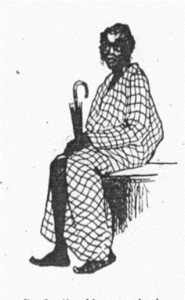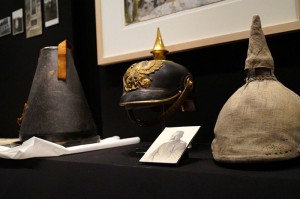In Germany, you cannot rely on the weather being consistently sunny, even in the summertime. In the fall at the latest – dare we think of it already? – we will need to shake open our umbrellas again. Axel Stähler (comparative literature, University of Kent), has shown that the umbrella was once considered a Jewish attribute. He recently offered to share with Blogerim his research on the umbrella’s discursive significance in Wilhelminian Germany.
Dr. Stähler, how did you spot the “Jewish umbrella”?

Mbwapwa Jumbo from “Briefe aus Neu-Neuland”, Schlemiel 1.1 (November 1903), p. 2
I was first struck by an umbrella in the hands of the “Big Chief of Uganda,” Mbwapwa Jumbo, a fictitious reporter in the Jewish satirical magazine Schlemiel, who acted as a correspondent from a new Jewish colony in Africa. In fact, in 1903, the British government had proposed to Theodor Herzl to commit land to Jewish settlers in the British Protectorate of East Africa. This proposal, which came to be known as the Uganda Plan, was vehemently disputed in the Zionist movement, and rejected in 1905. No concerted colonial Jewish settlement of Uganda ever took place, although individual Jewish immigrants had built homes there earlier.
In nine letters published over the course of the magazine’s brief lifespan, from 1903 to 1907, the chatty and naïvely amicable Mbwapwa tells of the first Jewish colonists – Orthodox Mizrachi – and of what became of them: in funny prose spotted with Anglicisms, and increasingly also Yiddishisms, he describes how he and his countrymen converted to Judaism. He relates the murder of a reformist rabbi who had been smuggled into the country, and the reformers’ ensuing punitive military expedition. He reports on the colony’s political and cultural trials and tribulations, and, finally, on the emergence of the Zionist movement—since Uganda was not, after all, the Promised Land. → continue reading

“Enthüllungen über das tragische Lebensende Lassalles” (An Exposé of the Tragic Death of Lassalle) by Bernhard Becker © Jewish Museum Berlin, photo: Leonore Maier
150 years ago today – on the last day of August, 1864 – Ferdinand Lassalle died as a result of injuries sustained in a duel. The German politician and journalist was a founder of the first workers’ organization in the country, the General German Workers’ Association, which had come into being the year before his death and is today still considered “the birthplace of social democracy”. Ferdinand Lassalle’s duel pistols were on display at the exhibition “150 Years of Social Democracy”, presented a year ago by the Moscow State Archive.
Both a politician and a charismatic agitator for the organization of workers, Lassalle was only 39 years old when he challenged Wilhelm von Dönniges to a duel because the latter had refused to grant Lassalle his daughter’s hand in marriage.
After his abrupt demise, a veritable cult of personality developed around his memory: there were poems, songs, even rituals carried out during the widespread commemoration ceremonies, as well as various pieces of memorabilia that circulated among his followers. The first book with “An Exposé of the Tragic Death of Lassalle” appeared in 1868, by one of his close political comrades.
→ continue reading
Or: How 300 Artifacts from our Collection Were Turned into a Cabinet Exhibition about the First World War

Objects from our collections in the exhibition “The First World War in Jewish Memory”
© Jewish Museum Berlin, photo: Mariette Franz
Our exhibition “The First World War in Jewish Memory” opened last week. It is based primarily on collections donated to the Jewish Museum by German-Jewish families and each exhibit tells a very personal story.
In total, 176 exhibits were selected, researched and arranged as a visual narrative by eight curators, six restorers, two exhibition technicians, a translator and a graphic artist. So, even before I mention our numerous willing helpers in the wings, in particular the student assistants and the Museum caretaker, this sounds like a big team for a big exhibition. In fact, our joint endeavor culminated in a small cabinet exhibition relating to the First World War, which can be viewed until 16 November in the Rafael Roth Learning Center. → continue reading


